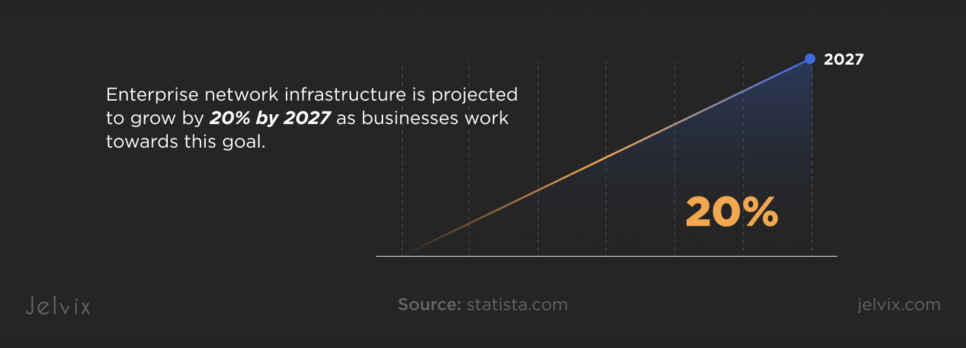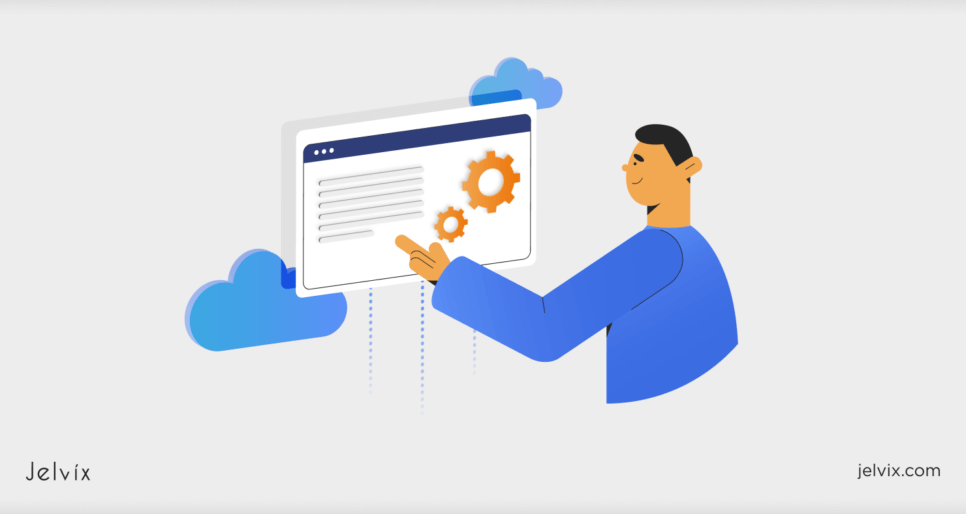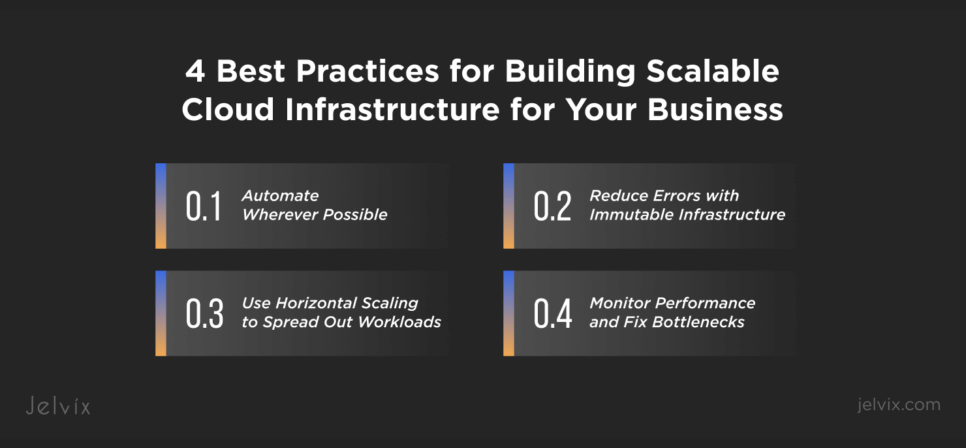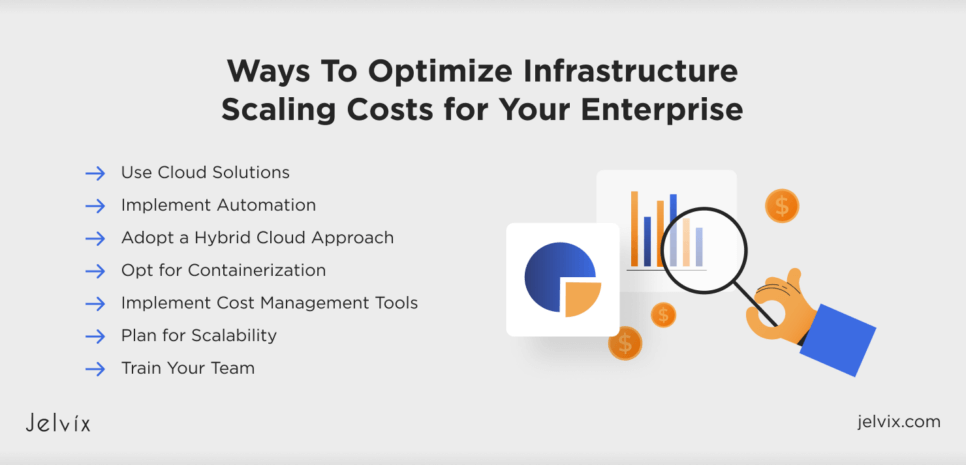With the increasing workloads and traffic, modern businesses seek to adapt to market changes by enhancing their IT infrastructure. Enterprise network infrastructure is projected to grow 20% by 2027 as businesses work towards this goal.
Although the benefits of scaling the existing IT infrastructure are clear, balancing scalability with cost-efficiency can be tough. The smallest disruption to existing processes can lead to extra costs related to fixing new issues.
If you aim to ensure cost-effectiveness while scaling your IT infrastructure, this article is for you. You’ll discover ways to evaluate your scaling needs, metrics that help measure success, tools that suit your needs best, and strategies to scale effectively without breaking the bank.
The Importance of Scalable IT Infrastructure for Enterprises
Business executives anticipate receiving at least 50% of their revenues from completely new products already by 2026. Scaling efficiently can make a huge difference in how quickly you can respond to such market demands, how many new services you can provide, and how much it may cost your company.
Time Efficiency
Businesses need to scale their IT infrastructure to handle increased workloads and respond to client needs. This way, they can decrease downtime, make user experience better, and benefit from more agile operations. Scalable solutions like cloud services or virtualization allow you to rapidly add resources when needed, ensuring your company can meet new demands without delays.
Handling Growth Efficiently
As your services become more popular, you will need more resources to meet customer demand. Scalable IT infrastructure allows your business’s technology to grow as needed. Whether it’s more storage, more computing power, or more bandwidth, scalable systems can expand to handle increased load without a complete overhaul.
Reliability and Performance
As businesses grow, so do their workloads. A scalable infrastructure ensures that your systems continue to perform well even under increased demand. This means fewer slowdowns and downtimes, leading to better user experiences. For example, an e-commerce website needs to handle thousands of transactions during peak sales periods. Scalable infrastructure ensures that these transactions are processed smoothly, maintaining customer satisfaction.
Future-Proofing
Technology evolves rapidly. Scalable IT infrastructure helps businesses stay up-to-date with the latest advancements. By adopting scalable solutions, you ensure that your systems can incorporate new technologies without significant disruptions. This adaptability is crucial for maintaining a competitive edge.
Operational Agility
Businesses need to be agile to respond quickly to market changes, customer demands, or technological advancements. The scalable IT infrastructure supports this agility. For instance, if there’s a sudden spike in website traffic due to a marketing campaign, a scalable system can handle the surge without crashing, ensuring continuous and smooth operations.
How To Evaluate Scaling Needs: Spotting Opportunities and Key Metrics
Evaluating enterprise scaling needs is essential for ensuring that a business’s software and systems can handle growth effectively.
Identifying Scaling Opportunities
By looking out for scaling opportunities, you can ensure your IT infrastructure grows smoothly and without costly delays.
Monitor Performance Issues
Start by looking at where your system might be having trouble. Pay attention to things like slow response times, frequent crashes, or high error rates.
Evaluate Software Architecture
Check how your software is built. Some designs like microservices are easier to scale than others, like monolithic designs.
Assess Infrastructure
Make sure your hardware and network can handle more use. This includes looking at servers, databases, and internet connections to see if they need upgrades.
Analyze Business Growth
Think about how your business is growing. Predict future needs based on expected increases in customers, transactions, and data storage.
Consider Vertical and Horizontal Scaling
Understand the two main types of scaling. Vertical scaling, for example, means making your existing machines more powerful (adding more memory or CPU). Horizontal scaling means adding more machines to your system.
Evaluate Cost Implications
Look at the costs of scaling options. Compare the expenses with the benefits, like better performance and customer satisfaction, to ensure it’s worth it.
Implement in Stages
Scale up gradually. This way, you can manage risks and ensure your system remains stable without making big changes all at once.
Perform Load Testing
Test your system under heavy loads. This will help you see how it performs when many users are using it at the same time, so you can make necessary adjustments.
Key Metrics for Evaluating Scaling Needs
Keeping track of important metrics can help you understand if you’re moving in the right direction and make timely adjustments to your scaling strategy.
CPU and Memory Usage
Track how much CPU and memory your servers use. If they’re consistently high, it might be time to add more resources.
Network Traffic
Monitor how much data flows through your network. Increased traffic might mean you need to upgrade your network capacity.
Response Times
Measure how long it takes for your applications to respond. Longer response times can hurt user experience and indicate a need for scaling.
Error Rates
Keep an eye on how often your system encounters errors or crashes. A rise in these metrics can point to overworked components.
User Load
Look at how many users your system supports at once. Your infrastructure should be able to handle an increased user base without performance delays.
The Best Tools and Technologies To Build a Scalable Infrastructure
Scaling your IT infrastructure can be complex, but with the right tools, it becomes much more manageable.
Cloud Computing Platforms
Cloud platforms offer flexibility and scalability, allowing you to adjust resources as needed without hefty upfront costs:
- Amazon Web Services offer services like computing power, storage, and databases that you can scale depending on your business needs;
- Microsoft Azure integrates well with Microsoft products and provides robust security features along with scalable cloud services;
- Google Cloud Platform offers ML features and data analytics, helping companies scale efficiently.
Containerization
Containers package an application and its dependencies together, making deployment and scaling across environments straightforward:
- Docker simplifies the development, shipping, and running of applications by containerizing them;
- Kubernetes is an open-source platform that automates deploying, scaling, and managing containerized apps.
Load Balancers
Load balancers help distribute incoming traffic across multiple servers, ensuring no single server is overwhelmed:
- NGINX acts as a high-performance load balancer and web server;
- HAProxy is open-source software that provides high availability, load balancing, and proxying for TCP and HTTP-based applications;
- AWS Elastic Load Balancing spreads incoming traffic automatically across multiple targets (like IP addresses, containers, and instances).
Monitoring and Management Tools
Effective monitoring tools are critical for maintaining performance and spotting potential issues early:
- Prometheus is an open-source monitoring toolkit designed for reliability and scalability;
- Grafana is a platform for monitoring that integrates with various data sources;
- Datadog is a cloud monitoring and security platform offering end-to-end visibility across your infrastructure.
Automation Tools
Automation tools help handle repetitive tasks, ensuring consistency and saving time for your staff:
- Ansible is an open-source tool that assists with task automation, making configuration management and application deployment easier;
- Terraform is an infrastructure as a code tool that lets you define and provide data center infrastructure using a high-level configuration language.
By using these tools, you can scale your IT infrastructure to meet growing demands, enhance performance, and maintain cost-efficiency.
Sometimes, companies can have a complicated infrastructure, which means standard tools can’t suit their needs. At Jelvix, we can offer custom healthcare and financial software development services to help you create solutions that provide the best cost-efficiency for your infrastructure needs.
4 Best Practices for Building Scalable Cloud Infrastructure for Your Business
Scaling your infrastructure effectively ensures your systems can handle increased loads without compromising performance or reliability. Consider the best practices listed below to create a robust cloud infrastructure for your needs.
Streamline Every Step
Automation optimizes processes, cuts down on human errors, and makes operations more consistent. Automation tools can handle tasks, such as configuration management, deployment, and scaling. This not only saves time but also frees up your team to focus on more strategic work.
Reduce Errors with Immutable Infrastructure
Immutable infrastructure means creating servers and systems that stay unchanged once they’re set up. Whenever you need to make updates, you just create new instances with the changes. This approach minimizes configuration drift and keeps everything consistent.
Implement Horizontal Scaling to Manage Workloads Efficiently
Horizontal scaling means adding more machines or nodes to handle the load, rather than just upgrading existing ones. This approach is flexible and cost-effective. AWS Auto Scaling and Kubernetes’ Horizontal Pod Autoscaler can help you easily implement horizontal scaling, ensuring your applications can smoothly handle traffic spikes and growing workloads.
Analyze Metrics and Overcome Hurdles
Keeping an eye on performance is critical for successful scaling. Monitoring tools can help you check and evaluate your system’s metrics, application performance, and user experience. Regularly analyze this data to spot bottlenecks and optimize your infrastructure.
Learn how we can help your business with a digital transformation strategy that addresses its unique challenges.
Ways to Optimize Infrastructure Scaling Costs for Your Enterprise
Scaling IT infrastructure can get pricey, especially if you don’t manage it well. The Jelvix team suggests that you follow a few proven strategies to keep costs in check while scaling effectively.
Use Cloud Solutions
About 57% of enterprises use multiple cloud providers. No wonder, as many offer pay-as-you-go pricing models, allowing you to pay for only the resources you use. This approach offers the flexibility to avoid substantial upfront hardware costs and to gradually add resources as needed.
Implement Automation
Automation tools can take care of repetitive tasks, such as configuration management and deployment. Automating these processes reduces manual effort, minimizes errors, and saves time, helping cut down operational costs.
Adopt a Hybrid Cloud Approach
A hybrid cloud approach, which uses both cloud and on-premises solutions, can be highly cost-effective. It allows you to scale resources on the cloud during peak times while keeping sensitive data secure on-premises. This balance can offer flexibility and savings.
Opt for Containerization
Containerization ensures maximum resource utilization. Containers are lightweight and can be easily scaled up or down based on demand, helping you avoid over-provisioning and unnecessary costs.
Implement Cost Management Tools
Take advantage of cost management tools provided by your cloud service provider. They help track spending patterns, set budgets, and identify areas where you can save money.
Plan for Scalability
Design your infrastructure with scalability in mind. This includes using scalable architectures like microservices, which allow you to scale specific components without having to overhaul the entire system.
Train Your Team
Invest in training your team on efficient resource use and cost-saving practices. An informed team can make smarter decisions about resource use and spot opportunities to save money.
Find out the potential cost of your enterprise solution development with a comprehensive estimate here.
Tips for Infrastructure Scalability in Healthcare
Although healthcare is a sensitive industry, medical cloud computing allows operating patient data safely and efficiently. Companies can adopt a few tips to maintain high standards of patient care and operational efficiency.
Focus on Preventive Care
Shifting the focus to preventive care initiatives can reduce the overall burden on healthcare facilities. Proactive health management reduces the need for acute care services, supporting scalable healthcare delivery.
Standardize Procedures
Standardizing clinical and administrative procedures ensures consistency and efficiency across your organization. Optimized workflows and reduced errors support scalable operations.
Automate Patient Management Tasks
Optimizing tasks like appointment scheduling, patient reminders, and billing through automation tools saves time and reduces human error. This can lead to smoother operations and enhance patient care.
Implement AI and Machine Learning
AI and ML can help you analyze large datasets, predict patient needs, and optimize resource allocation. These technologies enhance decision-making and automate routine tasks, making your infrastructure more scalable.
Adopt Mobile Health Technologies
Mobile health apps offer patients access to healthcare services on their smartphones. These apps reduce the burden on traditional facilities and provide scalable options for patient engagement and monitoring.
Read more about key strategies for scaling a SaaS business in healthcare to navigate challenges and seize growth opportunities.
10 Points To Consider To Build Fintech Cloud Infrastructure for Security and Scalability
Creating a cloud infrastructure for fintech involves balancing top-notch security with the ability to scale efficiently. To ease this process, the Jelvix team suggests that you follow a step-by-step approach described below.
1. Choose a Secure Cloud Provider
First, pick a cloud provider known for its strong security features. Make sure they can handle possible cloud computing security risks and offer extensive safety measures and compliance certifications like ISO 27001.
2. Implement Strong Access Controls
Limit access to sensitive data and systems. Use identity and access management tools, multi-factor authentication, and role-based access controls. This ensures that only authorized staff can access critical information.
3. Use Encryption
Encrypt your data both in transit and at rest. This means using strong encryption standards like AES and RSA for stored data and TLS for transmitted data. Also, secure your encryption keys to prevent unauthorized access.
4. Regularly Update and Patch Systems
Keep your systems and software up to date with the latest security patches. Automated patch management tools can help you stay on top of updates and reduce vulnerabilities.
5. Implement Network Security Measures
Protect your cloud infrastructure with firewalls, intrusion detection and prevention systems, and network segmentation. A virtual private cloud can help isolate your resources and control network traffic effectively.
6. Ensure Compliance
Stay compliant with regulations like GDPR. Regular audits and compliance checks are critical to ensure your cloud infrastructure meets all legal and regulatory requirements.
7. Use Scalable Architecture
Design your application architecture to be scalable. Break down your application into microservices and use containerization tools to scale individual components independently based on demand.
8. Implement Auto-Scaling
Use auto-scaling features provided by your cloud service to automatically adjust resources as needed. This helps handle traffic spikes and ensures optimal performance without incurring unnecessary costs during low-usage periods.
9. Monitor and Optimize Performance
Regularly monitor your cloud infrastructure. Identify and address any performance bottlenecks to keep your system running smoothly.
10. Conduct Backup and Disaster Recovery
Have a robust backup and disaster recovery plan in place. Use automated backup solutions and regularly test your disaster recovery procedures to ensure they work effectively.
Top Strategies for Optimising Private Cloud Cost-Efficiency
Optimizing the cost efficiency of a private cloud is essential for getting the best value from your investment.
Right-Sizing Resources
Right-sizing means adjusting the computing power, memory, and storage to fit your actual needs. Avoid over-provisioning, which is allocating more resources than necessary. Use monitoring tools to analyze usage patterns and adjust resources accordingly. This way, you only pay for what you need.
Automating Resource Management
Use automation tools to scale resources up or down based on demand. Automation can help turn off idle resources, schedule backups during low-usage periods, and manage workloads efficiently. This reduces manual intervention and minimizes waste.
Implementing Chargeback and Showback
Chargeback and showback systems help track and allocate costs to different departments or projects. Chargeback means billing departments for their actual usage, while showback simply shows the usage without billing. These systems promote accountability and encourage departments to use resources wisely.
Using Virtualization Technologies
Virtualization allows you to run multiple virtual machines on a single physical server. This maximizes the use of physical resources and reduces the need for additional hardware. By consolidating servers, you can save on energy, maintenance, and hardware costs.
Optimizing Storage Solutions
Optimize storage by using tiered storage solutions. Store frequently accessed data on high-performance storage and less critical data on cheaper, slower storage. Use data deduplication and compression techniques to reduce storage space requirements. Regularly clean up unused or obsolete data to free up space.
How Jelvix Can Help Optimize Infrastructure Costs for Scaling
New tech and growing customer demands make the IT market dynamic, pushing businesses to expand their operations. If you want to stay competitive and keep up with market trends, a well-thought-out scaling strategy may be what you need.
At Jelvix, we offer assistance in optimizing infrastructure scaling costs by developing and integrating advanced solutions for process automation and business analysis. Our specialists can provide a tailored consultation based on your current infrastructure abilities and future demands to make scaling budget-friendly and efficient. Contact us today to discuss your project needs.
Ready to take your project to the next level?
Achieve excellence with our skilled specialists and cutting-edge solutions.
















